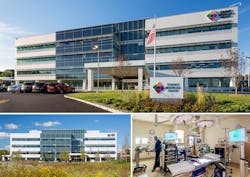At New Jersey’s Summit Medical Group, Sustained Growth and Success Through Strategy
In August of this year, the Berkeley Heights, New Jersey-based Summit Medical Group merged with CityMD, the leading urgent care provider in the New York City area. As a press release published on August 13 announced, “CityMD, the leading urgent care provider in the New York metro area, and Summit Medical Group, one of the nation’s premier independent multispecialty medical practices, today announced the completion of their merger – the first-of-its-kind between an urgent care provider and an independent physician-owned multispecialty medical group. The combined organization, which has more than 1,400 providers, over 6,400 employees, and nearly 200 locations in New Jersey and New York, will offer patients a seamless experience across a full spectrum of high-quality primary, specialty, and urgent care. Warburg Pincus, a leading global private equity firm focused on growth investing, has supported CityMD since 2017 and will assume a majority interest in the combined company. Consonance Capital Partners, a healthcare-focused private equity fund, is also making an investment in the combined company. Terms of the transaction were not disclosed.”
What’s more, the press release continued, “By leveraging CityMD’s strength in urgent care and Summit Medical Group’s expertise in coordinated, value-based primary and specialty care, the combined entity will create a uniquely accessible comprehensive care delivery model for patients in the NY/NJ metro area. Initial patient benefits will include co-located physicians and specialists in New Jersey, the growth of primary care providers in the New York market, and urgent care expansion.”
The press release noted that “Jeffrey Le Benger, M.D., who was at the helm of Summit Medical Group, has been appointed Chief Executive Officer of the combined organization. Richard Park, M.D., CityMD’s co-founder and CEO, will serve as its Vice Chairman. Rob Connor, CityMD’s President, will become President of the combined group.”
And it quoted Dr. Park as stating that “The combined organization will leverage the strengths of each entity to seamlessly manage the medical needs of various patient populations who deserve and expect exceptional consumer-oriented health care and customer service. The combined company will have the ability to treat more comprehensive and specialty-specific medical needs of patients through quicker, more reliable referrals and a highly coordinated care model.”
And the press release quoted Dr. Le Benger as stating that “The next chapter of Summit Medical Group’s long-standing history begins today with the formation of this unique entity. Our shared core value of taking excellent care of the patient will remain the cornerstone of our success as we set out to provide more access points for care, expand our primary care offering at a rapid pace, and grow our base of patients who will receive comprehensive care.”
Meanwhile, T.J. Carella, managing director at Warburg Pincus, said in a statement contained in the press release, that “We are excited to partner with CityMD and Summit Medical Group in establishing a world class integrated delivery network. We look forward to supporting this exceptional physician-led management team as they and the company’s clinicians deliver the high-quality care our communities deserve.”
Recently, Healthcare Innovation Editor-in-Chief Mark Hagland caught up with Dr. Le Benger, to get a sense of how things have been evolving forward at Summit Medical Group. Below are excerpts from that interview.
How have things been going since the merger in August?
It was a fantastic merger. For us—I feel we were the premier multispecialty group in the country, in terms of our integrated program in northern New Jersey that really looked at patient outcomes, and we were always in the top quartile; and we were the best in total cost of care of any group in New Jersey; and we had unbelievable NPS scores of 88 or 89. We were unbelievably excited about that, and then were able to bring in a standalone urgent care business; we had a higher-acuity urgent care division. But CityMD has a program within it called AfterCare, where they did an unbelievable job of managing that patient in that episode, working with patients in an urgent care environment, but they weren’t able to close the loop before.
And we’re building four major hubs in New York City, on Long Island, and in Westchester County. Since we’re a physician-run and physician-governed organization on the clinical and administrative sides, there’s an option there for physicians who do not want to be managed by hospitals or payers. And physicians do not want to be managed by hospitals. We know how to care for patients, and can set up a delivery model that’s beneficial to patients in the ambulatory space.
How many physicians do you have now?
We are now 1,700 providers; we were close to 1,000 at the time, and they were at about 600. About 20 percent of that number are allied health professionals. And in terms of goals and milestones, for us, we have managed through COVID extremely well. We set up tents on the outside, we screened every patient, PCR-tested every patient; we saw over 1 million patients coming through for testing, and we still have amazing volumes coming through CityMD, and have arrangements with New York City to manage that as well. We were able to withstand the economic hardship that has occurred to other groups, because of our diversification within our integrated healthcare model. We’ve done really well, and have protected almost all of our staff. We had a furlough for some of our staff, but were able to protect them.
What kind of volume are you at right now? How were you impacted by the COVID-19 pandemic?
In our urgent care line of business, CityMD, we’re at about 170 percent of where we were last year at this time, and that’s because of COVID. And we have partnerships within the NY metropolitan area to provide services for that. And the patients like our model of care. We have over 135 CityMD sites, by the end of this year, in the NY metropolitan area. For our integrated healthcare model, our volumes decreased 60-70 percent when it occurred, but literally within one day, we were able to go from maybe 20 virtual visits, to maybe 4,000 virtual visits. It took us from June to the end of August, but we are close to 100 percent of our pre-COVID volumes.
What percentage of patients are you seeing virtually now?
Probably less than 5 percent now. We screen everybody. And we have a virtual waiting room, where we have texting for when they come into the office. We have air handlers to circulate the air. We have the correct amount of PPE [personal protective equipment]. And we still have PCE [Perchlorethylene] for oncology. I have to give credit to Dr. Kerry Le Benger, my brother, an allergist/immunologist, for putting the right protocols in place. We have n 88 NPS score from our patients. He knows the data and he has great common sense.
How do you see your landscape, clinically, operationally, strategically, and financially speaking, at this moment?
One of the reasons why we decided to look for a capital partner—and we have a deal with Warburg Pincus [the New York City-based Warburg Pincus private equity firm], and it’s a wonderful partnership—when we did our deal, and we fought for this, but our clinical governance model is untouchable—how we manage patients, compensate our doctors, and manage our delivery model. Our growth and strategy is to create what we had in northern New Jersey, which is the premier integrated medical group in terms of integration of our care delivery model, including how we manage the ambulatory sector, chronic care, etc.—and we are spending millions of dollars to get our data and IT model to support our care management—and that’s why we decided that we needed a capital partner. When COVID occurred, it gave us liquidity. And we came out of this unscathed.
Are you technically owned?
They have a majority ownership in the company, just barely a majority.
But you retain complete physician governance?
Absolutely, 100-percent complete physician governance; I would not have done the deal had we not gotten that. And that is transferable, and will always be part of the charter of Summit/City MD. And that sets us apart from other deals that have occurred. We want to create what we had in NJ, on Long Island, in Westchester, in the boroughs. We now see 6 million visits a year. And for us to create a healthcare model that we have always been able to be in the top quartile of outcomes and quality, and always at the top of cost management, with great NPS scores among consumers, and top-level satisfaction among physicians—that helps us to be able to create that model and give the patient what they need and what they need it. Net Promoter Score.
What do the next two years look like for you and for physician groups nationwide?
Nationwide, I think that physicians are going to see major consolidation in the marketplace. Unfortunately, [the fee-for-service system forces physicians to] ramp up their volume to make ends meet. Their reimbursement is low, their costs continue to go up, and the data analytics they need to run their practice, are unbelievably expensive. Hospital systems want to fill beds and increase ancillary-based reimbursement, and want to consolidate. Only certain systems really integrate; most hospital systems just want to consolidate.
What’s the alternative to physicians either being controlled by hospital-based integrated health systems or by health plans?
Payers do try the clinic model and have been somewhat successful, but you are somewhat beholden to shareholders. So we have an option here, and have pursued it—these physician-run practices. In the New York City area, it’s us. In Chicago, DuPage; In Houston, it’s Kelsey Seybold. I do think that you will see consolidation occurring in the marketplace, and it will continue. And it’s probably for the best. And hopefully, it becomes a truly integrated system; and the total cost of care will be controlled. And until the bricks-and-mortar is just a cost center, you’ll never see a decrease in cost structure. We will continue to consolidate, which for us will increase our integrative methodology. It takes a little over a year to change culture and behavior when groups come into an integrated methodology. It might be naive, but I still look at the group as a family, and how we are collegial, and how you reach consensus within the group. So I think we have the ability to grow within the NYC metro area. And our model is always this hub and spoke model, focused on the ambulatory sector. And we’ve invested heavily into an algorithmic chronic care model, to really manage our sickest patients. And that is beneficial for the patient and the employer base as well as for our company, but really for the patient. Patients want to be seen outpatient, and they really want access.
This shift into value will only continue to intensify, then, correct?
Yes. There’s pay to play, when you get paid by filling out forms and pursuing certain forms of quality. Then you move up towards a shared-savings model; and then a fully capitated model, where you own the premium. I don’t know that we’ll ever get to that fully capitated model in the NYC area. In MA, we’re doing that now. In the commercial marketplace, it’s going to be slow.
Would you ideally like to be fully capitated in the commercial space?
Yes, where we have the capability to do so, I would love to move to a capitated product. We’re already doing that in Massachusetts. Right now, in the NY metropolitan area it’s still a FFS world; we have to beat the cost of care to compete. And we’re doing that.
Do you have any advice for leaders of medical groups that might follow you on this journey?
You have to have fortitude; you have to have perseverance. You need to have a consistent model as best as you can, within your group. And when you negotiate, you have to open up your eyes and see the truth. And what my father always told me is, it’s better to get 50 cents than no cents. You have to be careful when you grow. And how you grow, and cover your ramp, and have a really good finance department to be able to weather the storm on your debt or on growth. I’ve seen it very, very often: you commit to grow very fast but don’t know how to manage your debt. You need to continue to offer a quality product, and continue to pay your staff.
The physician practice management companies, PPMs, that emerged in the 1990s, failed because they consolidated practices, but didn’t really do anything else.
Yes, and that was a lesson learned: in the early 1990s, we were bought by MedPartners [a PPM company that notoriously grew very large, went public, and then crashed entirely]. I was only one of two doctors out of 45 who voted no. We got out of the deal two years later. That’s why we are a physician-run group and will never give up our governance model. I’m a head and neck surgeon, taught by one of the most head and neck surgeons at Mt. Sinai, and what he taught me was judgment, and to never make the same mistake twice.
PPMs were a total disaster. We were the first ones out. I had an unbelievable fight personally with Scrushy and McMillan, we got out. They bought you and owned you, lock stock and barrel. But when you do a private equity deal, you’re a partner with them; it’s a very different concept.


